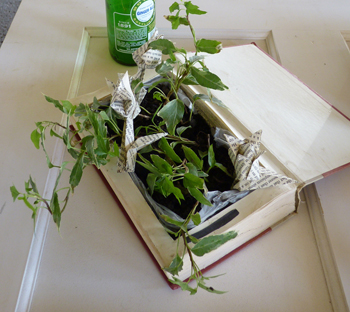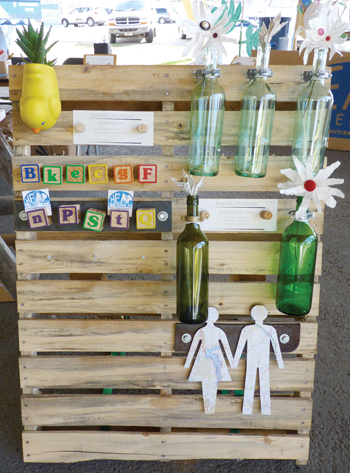HEAP Bozeman Creatively Reducing Bozeman’s Waste
 We collect an absorbent amount of waste. One weekly trip to the recycle center is a healthy reminder of how much we collect per household. If you are one who does not have curbside trash removal, removing your own trash is a rude reminder of just how much gets thrown away. There must be someone who could want some of the items we personally consider trash.
We collect an absorbent amount of waste. One weekly trip to the recycle center is a healthy reminder of how much we collect per household. If you are one who does not have curbside trash removal, removing your own trash is a rude reminder of just how much gets thrown away. There must be someone who could want some of the items we personally consider trash.
This is exactly what happened to Anna Hernandez. After moving to the mountains outside Bozeman and having to be responsible for her household’s disposal, she made a personal effort to minimize, recycle, and ”up-cycle”. Up-cycling coins the process of turning waste into something of higher quality or value. “Having to see our own garbage, we became avid recyclers and up-cyclers.” After her personal experience thinking about how to recycle and reuse, she wanted to provide a resource for Bozeman to do the same. “I want to share the benefits of thinking-before-you-toss by demonstrating it can be satisfying to create with what we already have, and making it convenient for others to change their habits,” Ms. Hernandez professes.
The Human Empowered Arts Project (HEAP Bozeman) is a nonprofit organization that launched in April, to be a “go to” resource for the community providing methods, sources, and ideas for the use of your garbage. This is beyond providing information for where to recycle and directions to the nearest dump. HEAP is a source that provides creativity, innovation, and education. Their mission states, “HEAP Bozeman inspires up-cycle creativity and empowers our community through environmental awareness and contribution”. HEAP will achieve this with a combination of educational programs, cooperatives, and eventually a store; a physical location where artists, students, and up-cyclers can go to gather and donate materials for projects.
HEAP Bozeman seeks other community programs with whom to partner, that could leverage HEAP’s offerings, such as their Up-cycle Instruction and Workshops. HEAP’s educational programs and workshops come with lesson plans and activities that provide creative ideas for up-cycling but ultimately educate children and adults to be better stewards of the environment. The Up-cycle Workshops and other educational curriculums can be leveraged by community centers, organizations, camps, schools, or just about any location looking to add something new to their education program. HEAP provides the lesson plan, materials, and instruction on making something useful and lovely, out of what might have gone into a landfill.
While HEAP Bozeman continues its discovery in the community and adding to its portfolio of ideas, they have also scoped a project per season to help provide visibility to its mission in action. April’s launch at the Gallatin Earth Day Celebration included a display booth created with recycled materials to showcase how items often quick to be tossed, can be reused. The summer project is still being drafted, but it will include participation at the 2012 Sweet Pea festival. Though not finalized, ideas circulating include providing useable creative methods for float building, displays, and an educational hand in the Children’s Activities area.
Another HEAP effort in the works is organizing The Thrift Cooperative to make thrift store shopping and donating more visible and convenient. The goal is to roll this out in conjunction with the start of the fall semester, curbing waste during MSU student moving. The community is used to placing its unwanted items on the sidewalk for the next interested party, and too often students purchase all new apartment and dorm furnishings, only to be pitched the next year at move out. Where can you donate or buy gentle used items? Bozeman is peppered with a variety of thrift stores for donating and gathering. HEAP intends to bring more awareness to these locations by providing The Thrift Cooperative map, marking locations for specific goods, and making it simple to reuse or donate, ultimately keeping things out of the landfill.
Anyone familiar with non-profit organizations understands that running them requires volunteers. Ms. Hernandez has a passion for coaching students the ways of the professional world and has embraced this by providing internship opportunities to interested and qualified students. HEAP got off the ground with the brain and man power of college interns majoring in architecture, art education, accounting, visual arts, and marketing. In return, these interns are gaining valuable practical business and real world experience. Marketing and writing intern, Samantha Middlestead, comments about her experience, “I am happy to be involved spreading the word on something new and seeing people’s interests”. Samantha helps maintain HEAP’s press information and social sites, experience most companies and organizations leverage and value. Ms. Hernandez’s is excited not only to expand the awareness with her team, but HEAP is an opportunity to balance her keen business skills and creativity together. To help these future graduates grow while helping the community reduce waste, “is the most fulfilling,” she admits.
What can we expect to see from HEAP Bozeman in the next year? HEAP also plans to coordinate The Artist Cooperative providing a place for creative minds to share project ideas, materials, and display their artwork in their own Eclectic Boutique. Lastly, HEAP will continue to work towards establishing a location for the store to be the ultimate resource for future Bozeman up-cyclers and re-users.
For those interested in partnering with HEAP for programs, opportunities to provide shared space, or general inquiries, you can find contact information on their Facebook and web site, heapbozeman.org.
Inspired to become an up-cycler but need inspiration, here is a HEAP Bozeman project idea to get you started, Caterpillar Planters. Artistically recycle cardboard egg cartons by creating a seed starter planter. With a few crafty garnishes have fun with the kids and turn it into a colorful caterpillar.
Take a card board egg carton box and cut off the top having 24 compartments (if using a dozen egg box).
Cut the halves, length wise, to form the “body” of with a row of 3 egg compartments.
Punch 2 holes in the first egg compartment to add pipe cleaners or cotton swaps, forming the antennae, and creating the caterpillar head. Paint colorful dots or stripes on the outside of the egg compartments.
Fill each cavity with soil and add your seed appropriately.
Once the seed sprouts, you can plant the entire cardboard cavity as you would a peat pot, into the ground, or larger planter, and the cardboard will biodegrade.
For the detailed instruction on this lesson plan, see “Kid’s Space” at www.heapbozeman.org. Keep a look out for more complementary lessons from HEAP Bozeman.